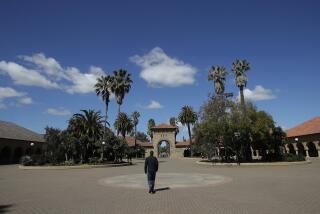Colleges nationwide may look at Californiaâs affirmative action plan
With the Supreme Court handing down a tentative decision on affirmative action Monday, many colleges nationwide may look to California, where voters banned racial preferences in 1996.
The 7-1 decision, joined by both conservatives and liberals, tells a lower court to take another close look at the admissions policy at the University of Texas.
The Timesâ Supreme Court reporter David Savage noted on Politics Now that the courtâs opinion does not strike down the Texas plan, nor does it appear to sharply limit affirmative action at colleges and universities around the nation.
[The ruling] does, however, say judges should look skeptically at the admissions policies that give weight to the race of some students.
Justice Anthony M. Kennedy, speaking for the court, said the justices in the past have permitted colleges and universities to pursue affirmative action to achieve diversity on campus. But he repeated that these policies should be narrow in their impact and must be justified in each instance as needed for diversity.
Federal judges had upheld the universityâs policy, but the Supreme Court reversed those rulings and told the lower courts to take another look at the Texas plan.
In California, UC officials say Californiaâs ban on racial preferences in admissions had âan immediate and dramatic adverse effectâ on minority enrollment. Supporters say the 17-year-old ban has affected only relatively few students at the most competitive campuses, and minorities overall have been well served throughout the UC and Cal State systems.
The numbers of black and Latino students dropped steeply at UCLA and UC Berkeley for a few years after the California ban took effect; those numbers have rebounded somewhat more recently but never returned to the percentages before voters approved Proposition 209 in 1996.
Yet across UCâs nine undergraduate campuses overall, the enrollment of blacks has nearly recovered. Latinosâ presence, after a temporary dip, has grown beyond its pre-1996 peak; this is partly due to the enormous increase in Latino populations in high schools.
UC has adopted a series of measures to lawfully enroll a more diverse student body. These include boosting outreach to high schools in low-income areas and widening admissions formulas. Financial aid was expanded too.
Undergraduate applications are reviewed differently, no longer relying solely on high school grades and standardized test scores but now placing those in context of studentsâ other talents, life challenges and family income. A student now can land a spot in UC, although not necessarily at UCLA, by being in the top 9% of his or her high school class, not just in the top tier of students statewide. UC also dropped the requirement for two SAT subject tests, something low-income and minority youths were more likely to skip or neglect, officials said.
At most of the 23-campus Cal State system, admissions standards are less rigorous than at UC. As a result, the system has done little to counter the effects of Proposition 209, other than to broaden recruitment from various ethnic groups, according to Cal State spokesman Mike Uhlenkamp.
More than the end of affirmative action, changes in the stateâs demographics affected minoritiesâ enrollments, he said. In 1996, blacks made up 7.8% of all Cal State students, compared with 4.8% last year. Latinos were 21.4% in 1996 and were up to 31.3% this year. However, minority students have a relatively small presence at the more competitive and engineering-heavy Cal Poly San Luis Obispo: less than 1% black and 13.6% Latino.
ALSO:
Sunday Supermoon captured on social media
Mosque-building rises as Muslim American clout grows
Heat wave to hit Southern California late this week, forecast says
More to Read
Sign up for Essential California
The most important California stories and recommendations in your inbox every morning.
You may occasionally receive promotional content from the Los Angeles Times.











